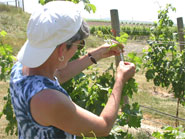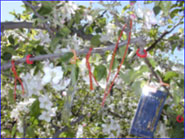WSU-FEQL Collaborative Research
(2001 to Present)
WSU University-wide Collaborations
- Dr. Patricia Butterfield, Dean and Professor, WSU College of Nursing. TERRA Nursing Actions Promoting Rural Low Income Children Environmental Health. 2013-2016
- Dr. Steve Sheppard, Professor Entomology and Dr. Tim Lawrence WSU Extension, Comparative evaluation of neonicotinoid residues in/on brood and stored pollen from PNW apiaries and rural landscapes. 2012- 2014
- Dr Lynell Tanagioshi, Professor Entomology Mt. Vernon. International export implications of pesticides found in US commercial blueberries production; Developing alternative application approaches to control a recent invasive pest. OR-WA Multistate 2012-2014.
- Dr. Zhang, Xiao, Assistant Professor, Engineering BSEL. A green conversion process to produce high value phenolic compound from biorefinery lignin. 2011-2015.
- Dr. Douglas Walsh, WSU Entomology. Evaluation of sunlight-exposed pyrethroid-treated netting for the control of face fly and housefly (Diptera:Muscidae) (2009-2013).
- Dr. David James: WSU Entomology. Improving conservation biological control of insects and mites by exploiting the chemical language of plants 2005-2011.
- Dr. David James: WSU Entomology. The prosternal gland in Pacific Northwest butterfly larvae with preliminary chemical analyses of emissions (2008-2012)
- Dr. Thomas Henick Kling, Director WSU Viticulture and Enology Program Director. Survey of Biogenic Amines in Washington Wines (2012).
- Dr. Jay Brunner: Research Center Director WSU Tree Fruit Research and Extension Center. Evaluating the efficacy of hand-applied dispenser technology for various mating disruption agents of codling moth 2001 to 2012.
- Dr. John Stark: WSU Research Center Director, Puyallup WA. Neurobehavioral effects from sublethal concentrations of pesticide mixtures in surface waters. 2005 to present.
- Dr. John Stark: WSU Research Center Director, Puyallup WA. Mixture effects of the nonylphenyl polyethoxylate, R-11 and the insecticide,imidacloprid on population growth rate and other parameters of the crustacean, Ceriodaphnia dubia (2008-2010)
- Dr. Mike Kahn, ARC Associate Director. Impacts-implications of the use of chemical alternatives to carbaryl for PNW shellfish. 2006-2012
- Dr Kim Patten: WSU Horticulture, Long Beach. Impacts-implications of the use of chemical alternatives to carbaryl for PNW shellfish. 2009-2012
- Dr. Vincent Jones: WSU Entomology, WSU Tree Fruit Research and Extension Center; Examining the mechanisms of mating disruption in codling moth and leafrollers (2003-2004)
- Dr. Bhaskar Bondada: WSU-Viticulture and Enology program, Physiological response of wine grape vines to 2,4-D acid and ester formulations (2005)
- Dr. Douglas Walsh: WSU Entomology. Terrestrial field dissipation assessments for fungicide candidates. 2003
- Dr. Douglas Walsh, WSU Entomology: Dislodgeable foliar worker exposure residue evaluations of Guthion and Sevin residues on Apple and Cherry Orchards. 2002.
- Dr. Larry Fox, Department of Veterinary Medicine, WSU. Direct determination of chlorhexidine residues in milk after intramammary infusion. 2002-2004.
- Dr. Marc Beutel, Department of Civil and Environmental Engineering. Controlling pesticides in runoff with natural treatment systems. 2004-2005.
- Dr. Rick Watts, Dept, of Civil and Environmental Engineering, WSU: Oxidative surfaces to minimize pesticide releases from mixing loading areas. 2000 to 2002.
- Dr Kim Patten: WSU Horticulture, Long Beach. Developing transitional and alterative chemical tactics to carbaryl for controlling burrowing shrimp (2005-2011).
- Dr. Kim Patton, Department of Horticulture, WSU: An integrated program for minimizing surface water degradation caused by cranberry farming. 2001-2002.
- Dr. Markus Keller, Department of Horticulture, WSU: Cultivar, rootstock, and seasonal effects on the variability in grape reproductive development. 2002-2003.
Collaborations and with Land Grant and other Academic Institutions
- Dr Matt Hengel: University of California, Davis. USDA IR-4 Magnitude of the Residue programs. 2000 to present
- Dr. Glenn Miller: University of Nevada. Gas-phase reaction of methyl isothiocyanate and methyl isocyanate with hydroxyl radicals under static relative rate conditions (2010-2014)
- Dr. Wei Qiang Yang, Associate Professor, Oregon State University North Willamette Research and Extension Center. International export implications of pesticides found in US commercial blueberries production; Developing alternative application approaches to control a recent invasive pest. (2012 to present)
- Professor George C Lognay, Gembloux Agricultural University Gembloux, Belgium. PhD chemical ecology Exchange program for Ms. Stéphanie Heuskin visit July-Sept 2008
- Dr Linda McCauley: University of Pennsylvania: Developing chemical biomarkers to determine pesticide exposure in children living near tobacco fields. OHSU collaboration as part of a NIH Center grant 2003-2005.
- Dr Joan Rothein: Oregon Health Sciences University. Developing chemical biomarkers to determine pesticide exposure in children living near tobacco fields. OHSU collaboration as part of a NIH Center grant 2003-2005.
- Dr. Glenn Miller: University of Nevada. Atmospheric reaction chamber experiments for determining chemical oxidation rates of insect pheromones. 2003
- Dr. John Middleton, Department of Veterinary Medicine, University of Missouri. Direct determination of chlorhexidine residues in milk after intramammary infusion. 2001 to 2004.
- Dr Richard Fenske School of Public Health and Community Medicine, UW. Near-field farm-family pesticide exposure and biomarker evaluations. 2002 to present.
- Dr Mike Yost, School of Public Health and Community Medicine, UW. Near-field farm-family pesticide exposure and biomarker evaluations. 2003 to2006.
- Dr. Robert Kreiger: UC Riverside, Dislodgeable foliar worker exposure residue evaluations of Guthion and Sevin residues on Apple and Cherry Orchards. 2002.
Federal/State Agency and Private Sector Research Collaborations
- Dirk Helder, EPA Region 10: WSU- FEQL 2012-2013 Franklin Co. Residential Air Monitoring Program. (2011-present).
- Dr. James Conca, Director of the Center for Laboratory Science; RJ Lee Group. Development of proton mass transfer mass spectroscopy applications for evaluating residential air quality from soil fumigation. (2010-present)
- Dr. Cynthia Lopez/Barb Morressey. Washington State Department of Health 2007-2009 WSU-FEQL State-wide Fumigant Air Monitoring Program. 2006- 2011
- Chris Voight, Director, Washington State Potato Commission, Understanding soil surface temperature dependent surface volatilization for the fumigant methylisothiocyanate. 2008-2011.
- Frank Tiggs with Crop Production Services. Assessing Near–Field Naturally Occurring Isothiocyanate Emissions after Mustard Green Manure Cover Crop Incorporation 2008-2009.
- Dr Cathleen Hapeman, USDA-ARS Beltsville, MD: Physical-chemical processes controlling odors and VOCs from agricultural operations. (Intramural funded USDA project
- Dr. Alan Knight, USDA-ARS Wapato, WA: Pear Ester Plus Sex Pheromone Dispensers for Mating Disruption of Codling Moth (Lepidoptera: Tortricidae). 2008-2011.
- Dr. Nat Scholtz, National Oceanographic and Atmospheric Administration. Neurobehavioral effects from sublethal concentrations of pesticides in surface waters NOAA Fisheries, Seattle WA. 2005-present.
- Ms. Sandra Halstead, EPA Region 10: Reduction of Insecticide Use in Orchards and Implementation of No-Spray Zones Through Alternative Spraying Practices;. 2005.
- Wilbur Ellis. Evaluation of airborne pesticide residues in air: Wilbur Ellis Pesticides Warehouse Fire Study. 2005.
- Jim Ossman, Western Farm Services. 2005 -2008 metam sodium field emission investigations. 2004 – 2012)
- Pacific BioControl Corporation: Improving release rate characteristics of codling moth mating disruption products; Mr. Jack Jenkins. 2001 to 2007.
- Washington State Department of Ecology: Evaluation of airborne pesticide residues in air: Wilbur Ellis Pesticides Warehouse Fire Study; Dr. Harriet Armman. 2005.
- Washington State Department of Health: Evaluation of airborne pesticide residues in air: Wilbur Ellis Pesticides Warehouse Fire Study; Dr. Barbara Morressey.2005.
- Suterra LLC: Improving release rate characteristics of codling moth mating disruption products; Mr. Tom Larson. 2002 to 2005.
- Syngenta Crop Protection. Determination of lambda-cyhalothrin in/on asparagus. Syngenta Crop Protection product understanding report. 2005.
- Dr. Greg Patton. Battelle Northwest Laboratories, Hanford WA: Aerial pesticide sampling. 2003.
- Dr. Karl Arne., EPA Region 10: Off-target herbicide monitoring; 2002 to 2004.
- DuPont Crop Protection. Terrestrial field dissipation assessments for fungicide candidates. 2003
- Washington State Department of Agriculture: Endangered Species Act and salmon protection; 2002 to present.
- Washington State Department of Agriculture: Of-target herbicide monitoring; Mr. Robert Arrington, WSDA Assistant Director. 2001 to 2003.
- Dr. Patricia Irving, InnovaTek Inc. Development of a nucleation sensor for the detection of CW agents in air. 2001 to 2002.

Air sampling

Vineyard pesticide exposure measurements

Codling moth pheromone dispensers
Heading using the h3 tag
Lorem ipsum dolor sit amet, consectetur adipisicing elit, sed do eiusmod tempor incididunt ut labore et dolore magna aliqua. Ut enim ad minim veniam, quis nostrud exercitation ullamco laboris nisi ut aliquip ex ea commodo consequat. Duis aute irure dolor in reprehenderit in voluptate velit esse cillum dolore eu fugiat nulla pariatur. Excepteur sint occaecat cupidatat non proident, sunt in culpa qui officia deserunt mollit anim id est laborum.